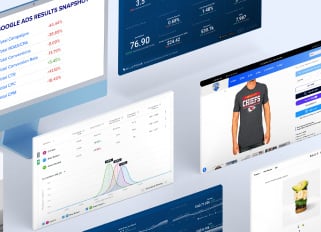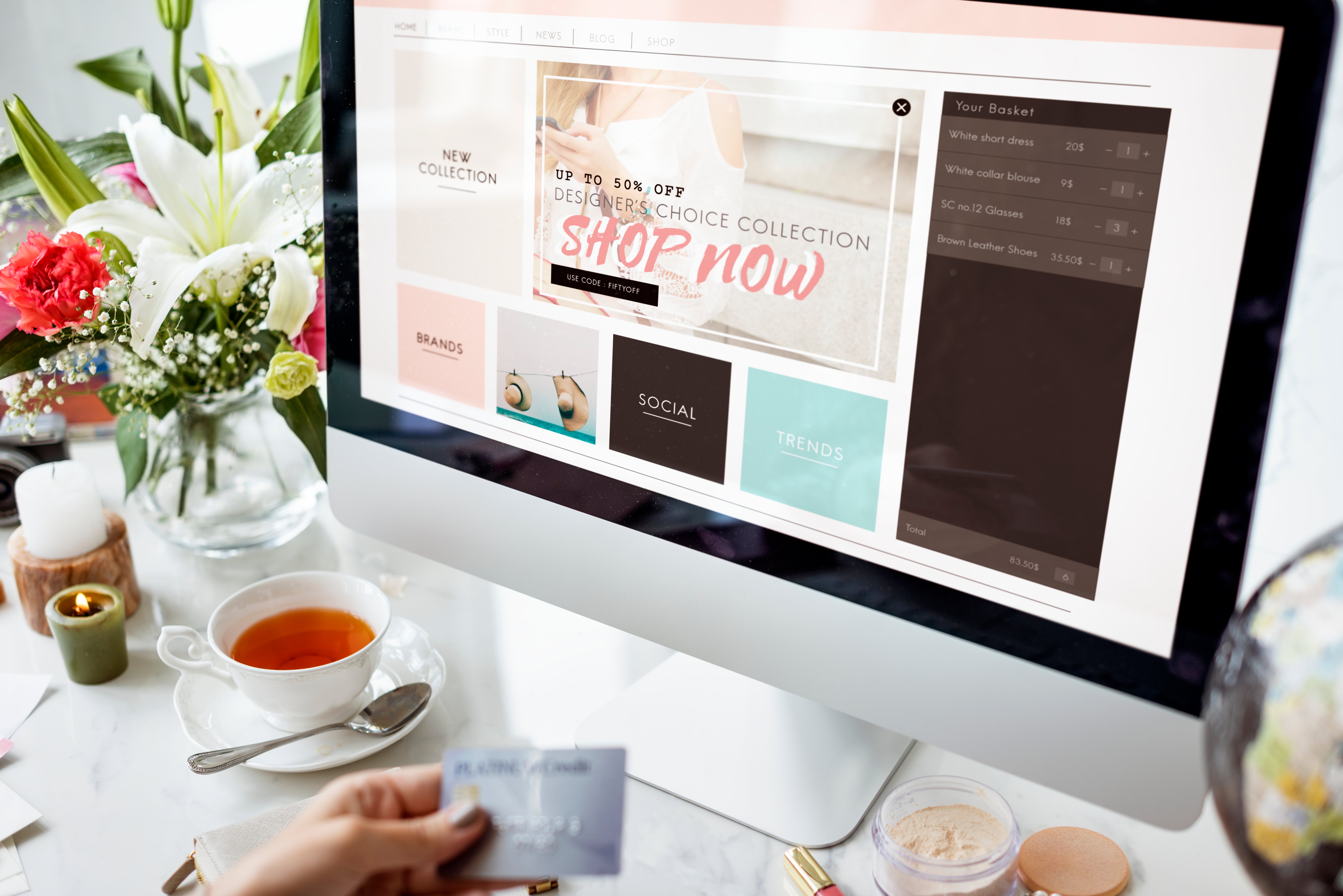
Upcoming Ecommerce Web Design Trends [Updated 2025]
Web design is constantly evolving, and ecommerce websites are no exception. As technology advances and consumer behaviors change, so do the trends in ecommerce web design.
That's why it's more than important for businesses to stay up-to-date with the latest trends to effectively reach and engage their target audience. So, what exciting web design trends are on the horizon for 2025? And how can you leverage them to give your site a fresh, modern look? Let's dive in!
Overview of Current E-commerce Web Design Trends
In recent years, ecommerce design trends have undergone a significant transformation, aligning closely with consumer expectations for seamless, intuitive, and visually appealing online shopping experiences.
Elements like minimalism, personalized user interfaces (UI), and high-quality visuals have come to the forefront. In addition, websites are now expected to be mobile-friendly and responsive, catering to the growing number of shoppers using their smartphones and tablets for online purchases.
Consider the example of Shopify’s use of clean interfaces, minimalistic design, and bold typography, enabling its merchants to provide a streamlined shopping experience. On the other hand, platforms like Etsy leverage high-quality visuals and personalized recommendations to delight their user base, further illustrating how current trends effectively captivate and convert visitors into loyal customers.
Upcoming Trends to Watch for in 2025
While current e-commerce design trends continue to hold relevance, several new and evolving trends are set to redefine ecommerce web design in 2025. These include:
AI-Powered Personalization
Artificial intelligence (AI) is transforming the e-commerce landscape, particularly in web design. As AI-powered personalization continues to gain traction, it is set to become an integral part of user experience design by 2025. With the ability to analyze user behavior in real-time, websites can tailor content, recommendations, and even design elements to match each visitor's preferences.
This heightened level of customization enhances engagement, encouraging users to stay longer on sites that feel personally tailored. For example, AI can dynamically adjust product recommendations, optimize content displays, and modify layouts to align with browsing habits.
Additionally, advancements in machine learning enable personalization to extend beyond content, influencing interactive design features, color schemes, and navigation choices. This revolution in design not only improves the customer experience but also drives sales by showcasing products that resonate n with individual users.
Augmented Reality (AR) and Virtual Reality
AR and VR technologies are gaining momentum in the ecommerce world as they provide an immersive shopping experience for customers. By overlaying digital images onto real-world environments, AR enables users to visualize products within their own space before purchasing. For instance, IKEA's "Place" app utilizes AR technology to allow users to see how furniture will look in their homes before buying it.
Similarly, virtual reality lets online shoppers explore and interact with products in a simulated environment, helping them make more informed purchasing decisions.
As these technologies continue to evolve and become more accessible, incorporating AR and VR into web design and your ecommerce store will become a mainstream trend for ecommerce websites in 2025.
Voice Search Optimization
As voice search and virtual assistants like Siri, Alexa, and Google Assistant gain popularity, voice-activated interfaces are emerging as a key trend in web design. Voice search-friendly websites enable users to navigate without typing, enhancing accessibility and user-friendliness.
To effectively integrate voice-activated interfaces, websites must develop voice command capabilities for search functions and interactive elements. This technology demands a clean, accessible design, ensuring users understand the available commands and how to interact with the site using their voice.
Full-page Headers
Full-page headers are the way to go for modern web design in 2025. Web designers can explore various header setups, but a popular layout features key text or call-to-action (CTA) buttons on the left and eye-catching images on the right. This approach leverages the natural tendency of readers to focus on the top-left corner of the page.
A great example of this is Discord’s website, which showcases a fun and quirky image on the right while highlighting the benefits of their paid service to the left. Their clearly marked CTA buttons guide users on what steps to take for enhanced experiences. As you scroll down, Discord organizes information into sleek, easy-to-read cards, maintaining a playful yet sophisticated vibe. This design strategy creates an immersive browsing experience that captures and retains customer interest.
Parallax Scrolling Effect
Parallax scrolling is a popular design technique that creates an illusion of depth and dimension by moving elements at different speeds. This effect adds a touch of sophistication to web design, allowing for more dynamic and engaging storytelling.
In e-commerce, parallax scrolling can be used to showcase products in various contexts or highlight their key features as users scroll down the page. The result is a visually striking website that stands out from competitors and encourages visitors to linger longer.
We can expect to see more creative use of parallax scrolling in 2025, incorporating elements like video backgrounds, product animations, and interactive graphics for a memorable user interface experience.
Dark Mode with Enhanced Customization
Dark mode has been gaining traction in recent years and is set to continue as a popular trend in 2025. This design trend uses dark backgrounds with lighter text, creating a sleek and modern look.
Along with its aesthetic appeal, dark mode also reduces eye strain and battery consumption for mobile devices with OLED screens. As more devices adopt this feature, websites will need to accommodate it for a seamless user experience.
Moreover, designers are pushing the boundaries of dark mode by introducing more customization options. In addition to traditional black backgrounds with white text, websites are experimenting with various color combinations to create unique and striking designs. These customized dark modes not only offer a refreshing visual experience but also allow brands to stand out and establish their own unique identity.
Micro-Interactions
Micro-interactions are small, subtle animations or effects triggered by a user's actions on the website. These interactive elements add an element of delight to the user experience and can also provide helpful feedback.
For example, a micro-interaction could be a subtle animation that appears when a user hovers over a product image, showcasing different angles of the item. This feature not only adds visual interest but also provides potential customers with more information about the product without having to click through several pages.
In 2025, micro-interactions will continue to evolve and become even more creative and intuitive in responding to users' actions, providing a seamless and engaging browsing experience.
Micro-Animations
Similar to micro-interactions, micro-animations are small animated effects that add personality and charm to a website. These animations can range from loading icons to playful illustrations that make the browsing experience more enjoyable for users.
In 2025, ecommerce brands will likely embrace more creative and interactive micro-animations on their websites. From product displays to checkout processes, these animations bring life and character to otherwise static product pages. This trend not only creates a unique brand identity but also increases user engagement and satisfaction.
White Space and Minimalism
In 2025, modern website design is embracing a return to minimalism, utilizing purposeful white space much like print magazines. This approach not only creates a sleek and contemporary aesthetic but also guides visitors seamlessly through site pages, allowing them to flow from one element to the next.
White space establishes a visual hierarchy, ensuring that no single element distracts from the overall composition. It provides the necessary breathing room for viewers' eyes to rest, enhancing comprehension by clearly defining relationships between page elements. When two elements are closely positioned, they are perceived as a unit, whereas greater distance prompts the eyes to regard them separately.
By strategically employing white space, designers can help visitors identify the most important information, ultimately improving the user experience (UX) of the site.
Color Trends in 2025
Color plays a crucial role in website design, as it evokes emotion and establishes a brand's tone.
In 2025, we anticipate a continued emphasis on vibrant colors and bold gradients. Designers are likely to create color schemes that not only resonate with specific emotions but also align with the brand's message. Additionally, incorporating accessibility features, like high contrast options, will become increasingly important to create inclusive websites for all users.
To fully capitalize on these trends, it's essential to understand the psychology behind color choices and ensure they align with your brand identity. Thoughtful color combinations and on-brand selections will be key to navigating these evolving web design trends successfully.
Role of Ecommerce Platforms in Implementing These Trends
To successfully incorporate these trends into an ecommerce website, it is important to have a reliable and user-friendly platform. Ecommerce platforms such as Shopify, BigCommerce, and Magento offer various features that can help implement these design techniques.
For example, parallax scrolling can be easily implemented using templates and plugins provided by these platforms. Similarly, dark mode and customization options are also available through various themes and plugins.
Micro-interactions and micro-animations can also be integrated through custom coding on these platforms or by using pre-made animations from marketplaces like Envato Elements. Moreover, these platforms also offer options for white space and minimalistic design through customizable layouts and templates.
Lastly, the platform's analytics and data tracking capabilities can help monitor the effectiveness of these design trends and make necessary adjustments to improve the user experience. A reliable ecommerce platform makes incorporating these design trends easier and more efficient.
The Future of E-commerce Web Design
Looking beyond 2025, the trajectory of ecommerce web design will be influenced by continued technological advancements and changing consumer behavior. The rise of 5G connectivity, for instance, will enable even more immersive online experiences, while blockchain technology might introduce new levels of security and transparency for online transactions.
The increasing emphasis on inclusivity and accessibility will also drive design innovations, ensuring that online platforms cater to diverse audiences with varying needs. By staying adaptable and open to new possibilities, businesses can position themselves to thrive in this dynamic landscape.
Ready to Revamp Your E-Commerce Website?
As we've seen, e-commerce web design is constantly evolving as technology advances and consumer preferences shift. To stay ahead of the game, it's crucial to pay attention to emerging trends and strategically implement them to enhance user experience and drive sales.
At BlueTuskr, we specialize in creating visually stunning, user-friendly e-commerce websites that meet the evolving needs of online businesses. Ready to take your brand's online presence to the next level? Contact us today to discover how to maximize your e-commerce potential!
Remember, staying current with trends isn't just about what's popular—it's about leveraging those trends to benefit your brand. Let's discuss how we can strategically implement them for your success!
Conclusion
The future of e-commerce web design is exciting and ever-evolving. By embracing minimalism and thoughtful use of white space, understanding color trends and their psychological impact, prioritizing user experience, and leveraging new technologies responsibly, businesses can create engaging online experiences that attract loyal customers.
Whether you're an entrepreneur launching a new e-commerce venture or a seasoned web designer, now is the time to keep your finger on the pulse of emerging ecommerce site trends. Adapt to changing consumer behaviors while staying true to your brand identity for long-term success in the e-commerce world. Embrace the evolving landscape and implement these strategies to ensure your online store stands out in 2025 and beyond!
Connect With Us
Recent Post

.png)





Tell us what you think!